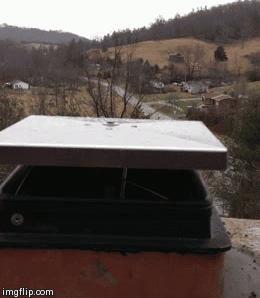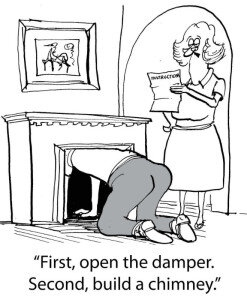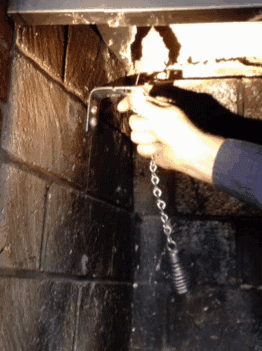Is There A Draft Coming From Your Fireplace?
If you’re noticing cold drafts swooping through your fireplace, you likely want to get the issue resolved in a hurry. Not only is this problem unpleasant and uncomfortable, it puts a strain on your energy bill too. Fireplaces are meant to provide a more affordable heating source for your home, but this doesn’t work so well if downdrafts are cooling down your home.Fortunately for homeowners in and throughout Littleton and its surrounding areas, Mountain Man Fireplace & Chimney has solutions for you. Learn more below, then give us a call for the fast, effective results you deserve.
Do You Need A New Damper?
An effective way to stop downdrafts is to update your damper. Most fireplaces are equipped with throat dampers that have worked well in the past, but now it grows faulty over the years. They provide a metal-on-metal seal and, if too much rust or corrosion occurs within the chimney, it may not be keeping your cold air out effectively. At Mountain Man Fireplace & Chimney, we recommend our customers to switch to a top-sealing damper instead.Because dampers are essential for controlling draft and airflow, having one that does the job is vital to blocking downdrafts and saving money this winter. A top-sealing damper is installed at the top of your flue, which ensures no cold air enters your chimney. They also have a rubber gasket, which guarantees a tight seal. With a top sealing damper, you’re sure to save money!
Have You Considered A Fireplace Door?
Having a fireplace door installed is another way to stop cold air from entering your home, and they also provide other great benefits. Along with keeping cold air out and warm air in, they stop stray sparks from jumping into your living room to hurt family members or ruin rugs and furniture. They even look great, too! It’s easy to find a door to match your style and decor, which ensures you get that high-quality look this holiday season. Need some installation help? We can help with that too!
Is A New Fireplace The Way To Go?
Sometimes, investing in a new fireplace or upgrading to an insert is a great if you want more heat and save energy. For example, putting a gas insert into a wood-burning fireplace eliminate major issues with draft. Inserts are known for high heat output and comfort.However, you must have your unit installed by a team of certified experts, and our team from Mountain Man Fireplace & Chimney is here to help! We have the tools and guarantee a safer and more comfortable season year after year. Ready to get started? We are, too! Don’t hesitate to give us a call today at 303-679-1601.
Consider Installing A Top Sealing Damper
Your chimney’s components each have a unique role in keeping the fireplace burning safely and efficiently. However, many chimney and fireplace components have changed little in the last century. One advancement in the industry that is improving efficiency and changing chimneys is the top sealing damper.
What are top sealing dampers?
Traditional dampers, also known as throat dampers, sit at the top of the firebox and separate the firebox from the rest of the chimney structure. The chimney is then open to outside air while the top of the flue is protected from the elements by a chimney cap.Top sealing dampers are installed on top of the chimney. This seals the entire flue off from outside air and the elements. The damper is still opened and closed using a lever or pulley when the fireplace is in use. Top sealing dampers have grown in popularity because of their functionality, safety, and ability to improve efficiency.
Do I still need a chimney cap if I have a top sealing damper?
If you decide to install a top sealing damper, your chimney will no longer need a chimney cap. Because of the location of the top sealing damper, it acts in the same was as a chimney cap when it is closed, keeping moisture, debris, and animals out of the chimney by forming an airtight seal around the top of the flue.The top sealing damper can be easily opened before a fire is started in the firebox; when the damper is open, the solid top protects against downdrafts and moisture getting into the chimney. Likewise, as a top sealing damper is only opened when the fireplace is in use the smoke, gas, and heat coming up the chimney act as a natural deterrent against animal entry.
How can my top sealing damper be more efficient?
Although they have similar functions not all dampers are created equal. Top sealing dampers differ from traditional throat dampers in that they can save you money on your heating and cooling bills; while they may not make your fireplace itself more efficient, they can prevent outside air from affecting the temperature inside your home.While throat dampers seal off the firebox, the flue is left open to outside air; this means that the air inside the chimney is subject to the same temperature changes as the outside air. The fluctuating air temperature inside the chimney can affect the temperature in surrounding rooms. This causes the HVAC system to work harder and run longer to keep your home at a constant temperature.Top sealing dampers can help minimize fluctuations in temperature inside your home; this means that your HVAC system can run less - and save you money on heating and cooling bills. Because the entire flue is sealed off from outside air, the air inside the chimney is less prone to temperature fluctuations. Likewise, keeping air inside the chimney at a constant temperature may make lighting fires easier.Top sealing dampers are effective, easy to use, and can even save you money on your energy bill each month. For more information on top sealing dampers, contact Mountain Man Fireplace & Chimney today!
Have Your Chimney's Damper Inspected
Why are dampers important?
- Broken pulley or lever: The pulley or lever allows you to open and close the damper when the fireplace is in use. If the pulley breaks, the damper remain stuck open or closed.
- Loss of airtight seal: If you can hear or feel air flowing through the damper even when it is closed, it may have lost its airtight seal. Exposure to heat or the elements can warp the metal of the damper and break its seal.
- Rust on the damper: Rust or oxidization of the damper is caused by exposure to moisture. Because of the location of the damper, the presence of rust is indicative of a chimney leak.
Dislodged Dampers Can Cause Drafting Problems
Dampers are designed to seal off the firebox from the rest of the chimney structure, creating an air-tight seal to prevent losing cooled or heated air up the chimney. Unfortunately, many homeowners use their dampers incorrectly or have dampers that have lost their seal; studies have shown that as many as 80% of all chimney dampers are left partially open when not in use.Even when they are closed, dislodged dampers may cause drafting problems. Understanding what causes them – as well as how they can be repaired – can help you get back to enjoying your fireplace sooner.
What is a chimney damper?
Most chimneys have throat dampers that separate the firebox from the rest of the chimney structure. Located at the top of the firebox, the damper is designed to create an air tight seal when closed. This prevents airflow between the heated and cooled air within the house and the outside air in the chimney structure.
How do dislodged dampers cause drafting problems?
Over time, chimney dampers can lose their air tight seal. Damper damage can be caused by chimney leaks, long term exposure to heat from the chimney, or the damper being opened or closed too forcibly. If the seal is lost, you may experience drafting problems.Damper drafting problems can have a number of symptoms. One of the most common signs of drafting problems caused by the damper is energy loss between your home and the outside air. A persistent cold spot in front of the fireplace during the winter – even when the damper is closed – can be a sign that your damper has lost its seal. Likewise, dislodged dampers may suffer from downdrafts, especially on windy days. When this occurs, gusts of air can blow down the chimney and into your home; these downdrafts are often accompanied by a smoky persistent smoky odor that lingers long after the fireplace has been used.Dislodged dampers don’t just cause drafting problems – they can also cost you money. When the damper is left open when the fireplace is not in use, heating and cooling costs can increase by as much as 30%. Even closed dampers that have lost their seal can continually let air in, increasing your heating and cooling costs each month.
Top mounting dampers and draft problems
Studies have shown that even well-fitting and correctly installed throat dampers may not be able to solve all drafting problems. Because of this, more and more chimney sweeps are recommending installing a top mounting damper.Top mounting dampers sit on top of the chimney at the entrance of the flue. When closed, they seal off the entire chimney structure from the outside. This not only prevents drastic temperature changes and differences in the chimney structure but can also almost eliminate problems with downdrafts and similar drafting problems.A dislodged damper can do more than just let small amounts of air in and out; it can also lead to chimney drafting problems as well as lead to higher energy bills. Whether your damper has become dislodged or you’re interested in replacing it with a top sealing damper, contact Mountain Man Fireplace & Chimney today to find out what a new damper can do for your chimney!



